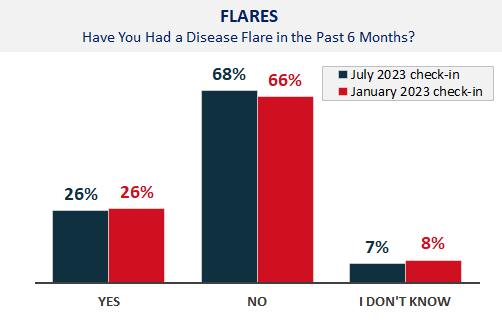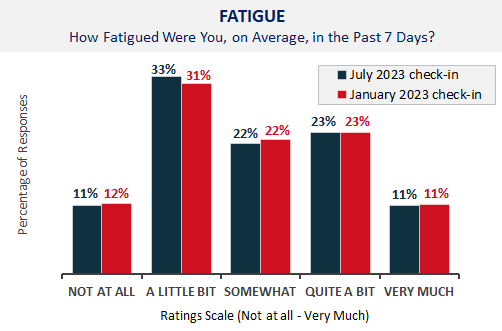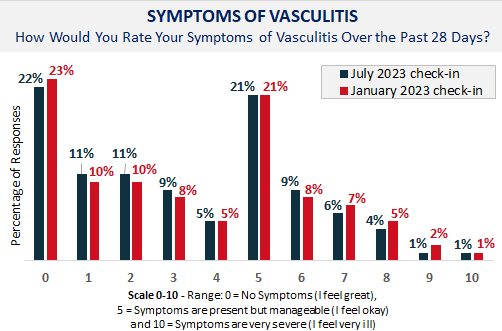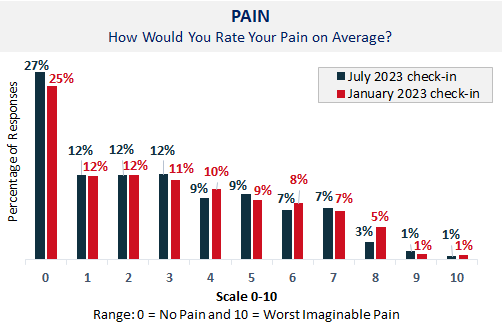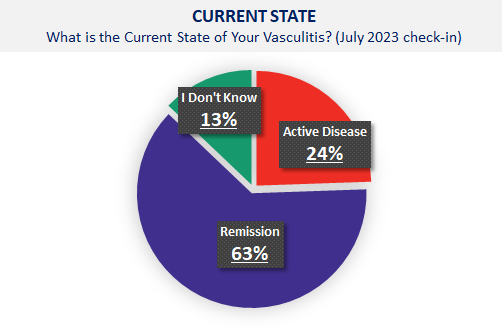VPPRN Patient-Powered Research
VPPRN Community Dashboard
6-MONTH CHECK-IN FORMS
January & July 2023
Take a look below at what we learned from the VPPRN community about Flares, Fatigue, Pain, Symptoms of Vasculitis and Current State of Vasculitis from the January and/or July 2023 check-ins.
What did we learn about FLARES and VASCULITIS?
Overall, we see similar rates of reported flares at both the January and July 2023 check-ins.
- About two-thirds of patients in the VPPRN community did not report a vasculitis flare in the past 6 months.
- We see approximately 26% of patients who did report a flare.
To better understand why some patients with vasculitis experience flares and some do not, we need the VPPRN community to continue to provide patient data to do the research needed to find answers. Patients power research in vasculitis! Please continue to share your health updates with us and continue to stay engaged in research.
What did we learn about FATIGUE and VASCULITIS?
Overall, we see similar numbers for fatigue ratings at both the January and July 2023 check-ins.
- We learned that most patients (over 88%) experience some fatigue related to their vasculitis.
Fatigue is not uncommon among patients with vasculitis. Patients may have fatigue even if other vasculitis symptoms are under control. By completing the VPPRN check-in forms every 6 months, it will tell us more about fatigue and its impact on quality of life for people living with vasculitis. This research is vital and may lead us to identify ways to improve overall quality of life.
What did we learn about SYMPTOMS of VASCULITIS?
The scores for symptoms of vasculitis are comparable at both the January and July 2023 check-ins.
- Most patients reported as either having no symptoms of vasculitis (22% and 23% with score = 0) or experiencing moderate symptoms (21% with score = 5) over the past 28 days.
- While the majority of the VPPRN community scored on the lower half of the scale (77% and 79% with scores 0-5 on a scale of 0-10), there were approximately 6%-8% in January and July who scored on the higher end, with scores ranging from 8-10.
What explains the range of responses? More research is needed to better understand why some people do better than others. That’s why it is important for you to check-in with the VPPRN every 6 months – even if there are no updates to report, or if your vasculitis is not currently active – this information is important as we collect information over time. The more data we have, the more answers we can find!
What did we learn about PAIN and VASCULITIS?
The ratings for pain are quite similar when comparing January and July 2023 scores.
- Approximately 50% of patients in January and July experienced little to no pain on average, with scores ranging from 0-2 on a scale of 0-10.
- Alternatively, almost 30% of patients with vasculitis experienced moderate to severe pain with scores 5 and above in both January and July.
Why do some people experience more pain than others? That is a good question and one that the VPPRN wants to understand more as we collect data over time with our 6-month check-in forms.
What did we learn about Members’ CURRENT STATE of VASCULITIS?
At the July 2023 check-in, we asked our Network members to tell us their current state of vasculitis.
- About two-thirds of patients in the VPPRN community reported that they are currently in remission. This is encouraging to see.
- We do, however, see approximately 24% of patients who reported that their vasculitis is currently active.
To better understand why some patients with vasculitis are in remission and some are not, we need the VPPRN community to continue to provide their data to the VPPRN. The data provided is mobilizing our team of doctors and researchers with the information they need to work towards improving the quality of life for all patients across all types of vasculitis and ages.
How Do You Compare To Others In The VPPRN Community?
Click below and see how patients with each type of vasculitis compare with the VPPRN community as a whole.
Compared to patients with other forms of vasculitis, patients with Behçet’s Disease (BD) reported more flares and higher scores for fatigue, symptoms of vasculitis, and pain at the July 2023 check-in. Additionally, a larger percentage of patients with BD reported their vasculitis as active.
Central Nervous System (CNS) Vasculitis
At the July 2023 check-in, patients with central nervous system vasculitis (CNSV) reported more flares and higher scores for fatigue, symptoms of vasculitis, and pain when compared to patients with other forms of vasculitis. Additionally, a larger percentage of patients with CNSV reported their vasculitis as currently active.
Cryoglobulinemic Vasculitis (Cryoglobulinemia)
Compared to patients with other forms of vasculitis at the July 2023 check-in, patients with cryoglobulinemic vasculitis (cryoglobulinemia) reported more flares, higher scores for fatigue, symptoms of vasculitis, and pain, and a higher percentage of patients reported active vasculitis.
Eosinophilic Granulomatosis with Polyangiitis (EGPA)
Compared to patients with other forms of vasculitis, patients with eosinophilic granulomatosis with polyangiitis (EGPA) reported similar scores/ratings for flares, fatigue, pain, and current state of vasculitis at the July 2023 check-in. Patients with EGPA, however, scored their symptoms of vasculitis higher than others in the VPPRN community.
Giant Cell (Temporal) Arteritis (GCA)
Compared to patients with other forms of vasculitis, patients with giant cell (temporal) arteritis (GCA) reported similar scores/ratings for flares, fatigue, pain, and members’ current state of vasculitis at the July 2023 check-in. We do see a difference in the scores for symptoms of vasculitis, with a higher percentage of patients with GCA reporting no symptoms at all.
Granulomatosis with Polyangiitis (GPA)
Compared to patients with other forms of vasculitis at the July 2023 check-in, patients with granulomatosis with polyangiitis (GPA) reported similar scores/ratings for fatigue, symptoms of vasculitis, and pain. However, there were differences in the reporting of flares and current status of vasculitis, with patients with GPA reporting fewer flares and a smaller percentage reporting active vasculitis.
IgA Vasculitis (Henoch-Schönlein)
Compared to patients with other forms of vasculitis, patients with IgA vasculitis (Henoch-Schönlein) reported similar scores for fatigue, pain, and reporting of active vasculitis at the July 2023 check-in. We do see differences in the flares reported and scores/ratings for symptoms of vasculitis.
Microscopic Polyangiitis (MPA)
Compared to patients with other forms of vasculitis, patients with microscopic polyangiitis (MPA) reported similar scores for fatigue and symptoms of vasculitis at the July 2023 check-in. There were differences in the reporting of flares, pain, and active vasculitis.
Compared to patients with other forms of vasculitis, patients with polyarteritis nodosa (PAN) reported similar scores/ratings for flares, fatigue, and reporting of active vasculitis at the July 2023 check-in. We do, however, see differences in the scores for symptoms of vasculitis and pain.
At the July 2023 check-in, patients with Takayasu’s arteritis (TAK) reported similar scores for fatigue and pain when compared to patients with other forms of vasculitis. We do see differences in the flares reported, scores/ratings for symptoms of vasculitis, and reporting of active vasculitis.
Compared to patients with other forms of vasculitis, patients with urticarial vasculitis reported similar scores/ratings for fatigue, symptoms of vasculitis, and pain at the July 2023 check-in. We do see higher numbers among patients with urticarial vasculitis on reporting of flares and active vasculitis.
Compared to patients with other forms of vasculitis, patients with other/suspected diagnosis reported similar scores for fatigue, symptoms of vasculitis, and pain at the July 2023 check-in. The differences we see are in the reporting of flares and members’ state of vasculitis.
WHAT’S NEXT?
CLOSED STUDIES UNDER ANALYSIS
Learn about the open VPPRN studies and how you can participate.
![]()
Sleep-Vasc: Quality of Sleep in Vasculitis
Goal: Through this study, we hope to learn more about the quality of sleep of patients living with vasculitis.
Study is now closed and under analysis.
VascStrength (VascStrong)
Goal: To describe the prevalence of common health conditions associated with frailty in patients living with vasculitis and describe its impact on health-related quality of life and clinical outcomes.
Study is now closed and under analysis.
OPTIONS: Options and Preferences for Treatments Informing recOmmendatioNS
Goal: To better understand patients’ values and preferences about plasma exchange in ANCA associated vasculitis.
Study is now closed and under analysis.
VascSkin: Skin Vasculitis Quality of Life Survey
Goal: To better understand the impact of vasculitis-related skin involvement on patients’ quality of life.
Study is now closed and under analysis.
AAV Response Criteria Delphi
Goal: To better understand coronavirus concerns of patients with vasculitis and track respiratory illnesses across the United States and Canada.
Study is now closed and under analysis.
Vasculitis Diagnostic Validation Study
Goal: To explore novel methods to provide a feasible approach to diagnostic confirmation for use in future patient-reported registries like the VPPRN.
Study is now closed and under analysis.
OPEN STUDIES
These VPPRN studies are currently closed for enrollment. The data from these studies is currently under analysis.
![]()
VCRC-VPPRN EGPA Registry
Goal: To conduct clinical research and clinical trials to learn more about EGPA with the goal of improving management and treatment of this complex disease.
Who Can Participate? Any patient with a diagnosis of EGPA.
Vasculitis Pregnancy Registry (VPREG)
Goal: The primary objective of this study is to understand pregnancy characteristics and outcomes among women with vasculitis.
Who Can Participate? Patients who are currently pregnant and over 18 years of age.
More Research is Coming!
There is still much to learn about vasculitis, and the VPPRN community can change that. The VPPRN is a PATIENT-POWERED network which means that PATIENTS POWER VASCULITIS RESEARCH.
The more patient data our VPPRN community provides, the more answers we can find. Why do some patients do better than others? How can we better understand why these differences exist? The answer is research.
Please stay involved and engaged in the VPPRN, and please continue to share your health updates every January and July.
We are stronger together. Together we make a difference.

Are you a member of the VPPRN?
Our vision is to improve the health of vasculitis patients by developing early-diagnosis methods, discovering more effective treatments, and finding cures. We are inviting thousands of patients with vasculitis, and caregivers, to come together to learn more about symptoms, share experiences, and to become a part of a research network to improve lives.
It is a whole new way of finding answers for the questions most important to YOU and other patients living with vasculitis.
Thank You
THANK YOU to all 1,326 VPPRN members who shared their health updates with us last January
and all 1,420 VPPRN members who did so in July 2023!
We appreciate your enthusiasm and continued engagement with the VPPRN!
Questions?
Please note, our research team is here to make participation in this study easy for you. The study coordinator is available for you to contact if you have any questions or concerns. Contact the Study Team at christine.yeung@pennmedicine.upenn.edu if you have questions about the study.


